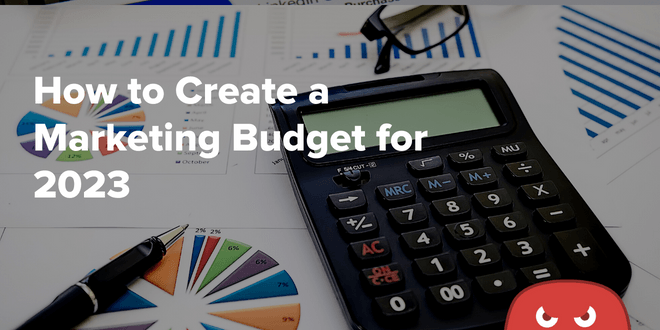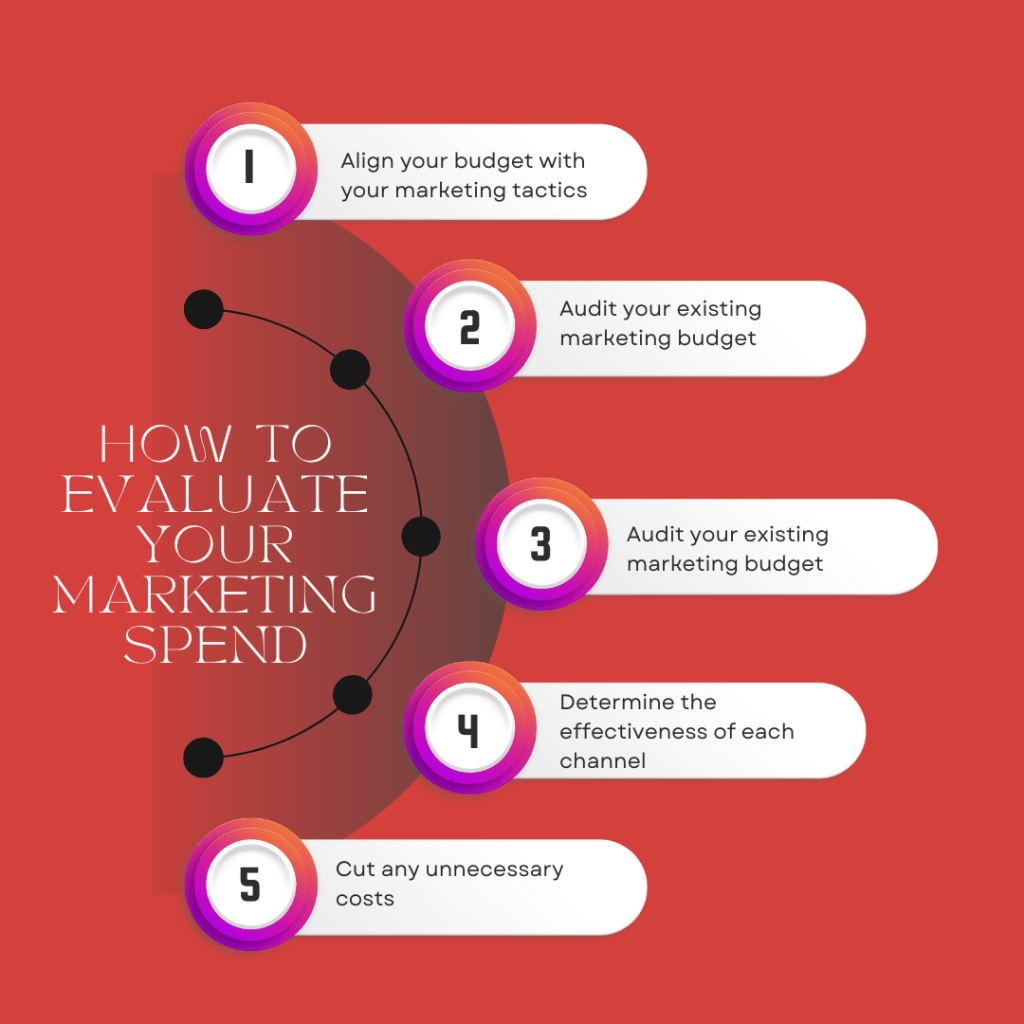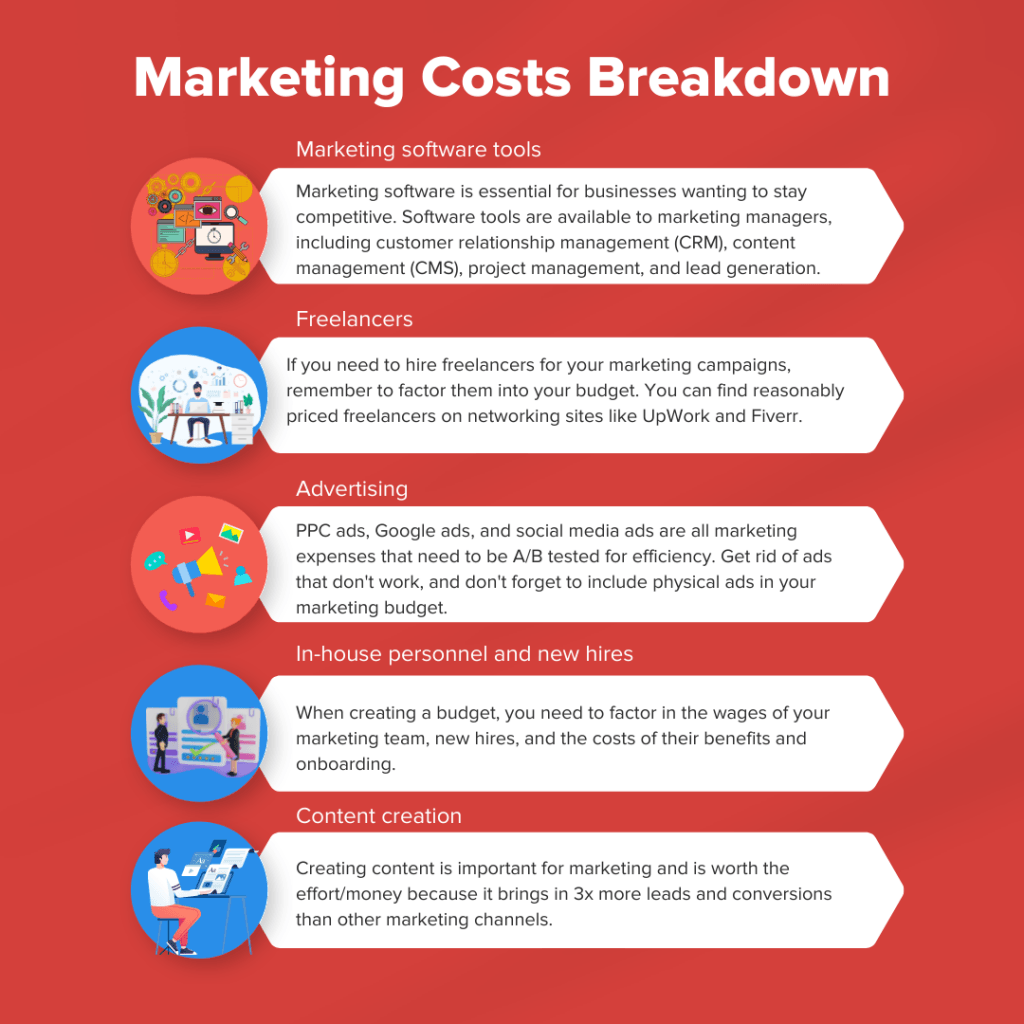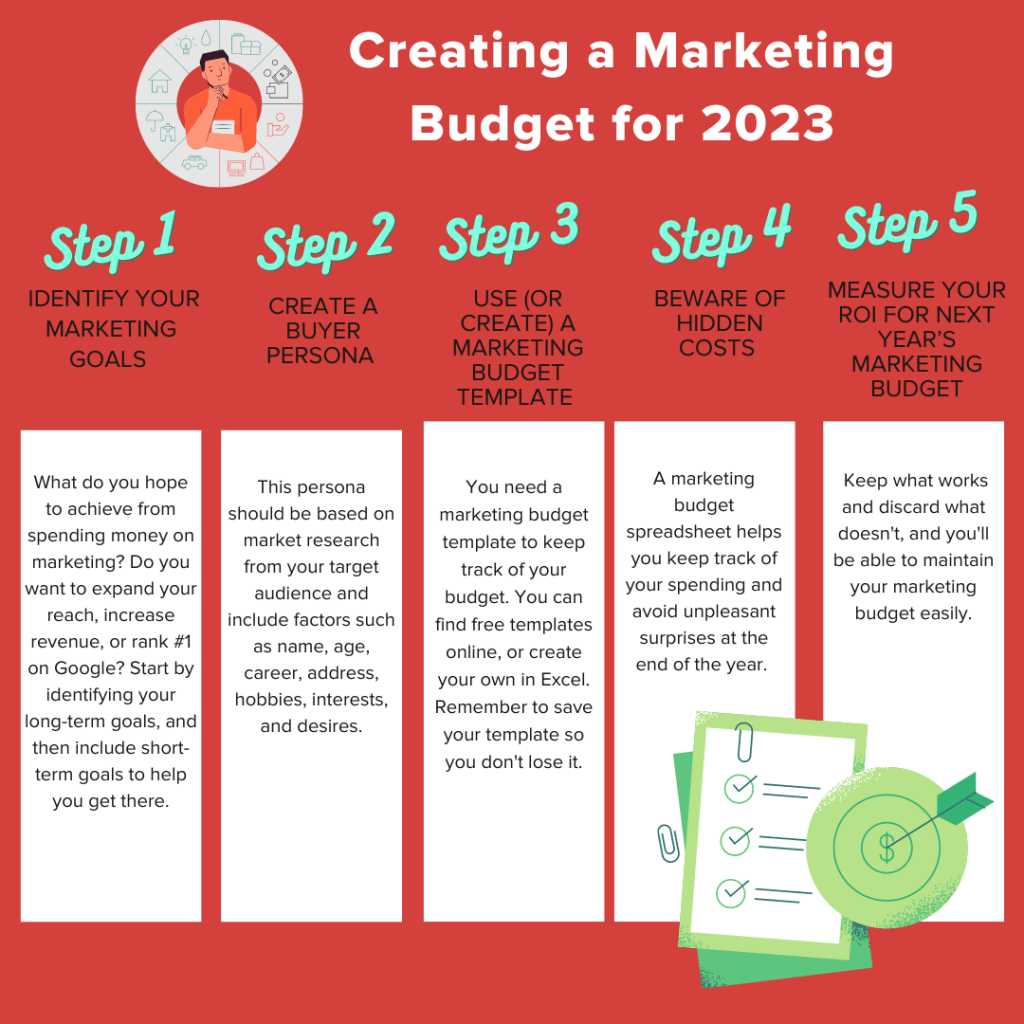Quick Links
Before you propose your new ad strategy using interactive 360° video walls around town, you need to stop and consider the marketing expenses involved.
While that’s certainly an extreme example, many marketers fall into the trap of not forming a budget plan for their content marketing efforts – which can cause their eyes to become bigger than their wallets.
Sure, it’d be great to roll out an innovative new digital marketing campaign using interactive technology, but if you can’t afford it, there’s no way it’s going to happen.
While budget restraints often crush more ambitious ideas, being able to form a realistic marketing budget is a necessity for any organization that wants to survive, especially small businesses.
It’s no secret that the pandemic wreaked havoc on overall marketing spending during 2021, but it’s beginning to bounce back.
In fact, the average market budget rose to 9.5% of company revenue in 2022, up from 6.4% in 2021, and the numbers are continuing to rise. It won’t take long before market budgets return to where they were before the pandemic, which was around 10.9%.
That means small business owners will have a bit more money to allocate toward marketing in 2023, which is why you need to learn how to create a smart yet realistic marketing budget.
Read on to learn how you can develop a budget that helps you meet (or exceed) all your marketing goals for the coming year.
The Importance of Marketing Budgets for Small Businesses
A proper marketing budget will outline all of your marketing investments and expenditures, including:
- Paid advertising
- Pay-per-click ads (PPC)
- Website domains (including blog domains)
- In-house marketing staff and new hires
- Software tools (CRMs, project management, etc.)
- Sponsored web content
- Freelancers
- SEO
- Backlinks
- Any other channels you use
As you can see, quite a bit goes into a marketing budget, and you don’t want to leave anything out, or you risk spending too much when it’s already too late.
Why are marketing budgets so crucial for small businesses?
They are because you need an airtight marketing strategy if you want to scale your business.
If you overspend on advertising, you’ll eat up a large portion of your revenue, and scaling will become very difficult.
Conversely, if you don’t spend enough on marketing, you won’t be able to acquire enough new customers to scale.
That’s why small businesses, more than any other sized business, need to master their marketing costs. By hitting the sweet spot between over and underspending, you’ll be able to acquire new customers without eating up all your revenue.
Also, by paying attention to essential metrics along the way, you’ll be able to measure your return on investment (ROI) to ensure you’re getting the most value from your marketing dollars.
Knowing which tactics to focus on
Constructing a winning budget means discovering which marketing tactics are the most effective. For instance, B2B marketing tends to focus on informative blogs and follow-up emails to guide prospects down the sales funnel.
On the other hand, companies targeting Gen Z’ers and millennials will have more success producing video content on social media platforms like YouTube, TikTok, and Instagram.
How do you know which type of content/advertising to focus on?
This is where knowing your target audience comes into play. It’ll take some serious market research on your part to uncover the channels that your audience prefers to use (i.e., blogs, videos, emails, social media, etc.).
From there, you can develop a content marketing strategy through the marketing channels your prospects use the most.
Determining the Right Marketing Budget for You
The first step in creating a marketing budget is to take stock of all your current marketing activities.
That will provide you with a foundation to build on (unless you find that you’re overspending, in which case you’d have to scale your efforts back). In 2022, the average marketing budget accounts for 9.5% of a company’s revenue, but is that the right number for you?
Consider that B2B companies have a higher average due to lengthy sales cycles, with their budgets accounting for 13% of company revenue.
As such, the type of business you have will also determine the size of your marketing budget. If you’re a brand-new startup, you’ll need to allocate a significant portion of your budget to building brand awareness, for example.
Here are some steps to follow when evaluating your marketing spend.
Align your budget with your marketing tactics
Ensure that you’re spending money on the right type of marketing activities that your target audience responds to the most.
For instance, if you’re spending money on short videos that appeal to Gen Z’ers, but your product is for older generations, you need to rethink your strategy. Otherwise, you’re flushing your marketing dollars down the toilet.
Remember, the goal of marketing is to achieve an ROI. Thus, if you’re seeing no revenue from all the money you’re spending, it’s time to A) go back to the drawing board and B) stop producing ineffective content.
You’ll find the greatest success when your marketing strategy and budget work in tandem, so strive for that.
Audit your existing marketing budget
If you don’t have a grasp of your current marketing budget, you’ll need to calculate it.
How do you do that?
You do this by adding everything you spend on your marketing plan each month, quarter, and year. Beyond that, you need to segment your budget by your current marketing initiatives.
Let’s say that your initiatives are to increase brand awareness and to retarget prospects that left without checking out. In this scenario, you would segment your marketing tactics according to these two initiatives.
It would look something like this:
Initiative 1: Build brand awareness
- PPC ads
- Influencer marketing
- Social media marketing (posts, quizzes, surveys, etc.)
- Search engine optimization (SEO)
- Blogging and guest posts
Initiative 2: Retargeting
- Email marketing (retargeting emails)
- Pop-up windows
- CTA buttons
- Google ads
- Promotional blogs
As you can see, each initiative has content supporting it listed underneath. For your budget, you should also list the amount you spend next to each item to calculate your budget.
Determine the effectiveness of each channel
As stated before, the goal of any marketing campaign is to achieve a return. That’s why you’ll need to check how effective each marketing channel has been for you in the past.
If you’re spending a large chunk of your budget on videos that aren’t generating leads or conversions, they aren’t worth the money.
You’ll need to check your metrics to determine how effective each channel is for your business.
How do you do that?
Tools like Google Search Console and Google Analytics are fantastic tools for seeing which pieces of content perform best for you.
Using them, you can check metrics such as:
- Total organic traffic
- Leads generated
- Conversions
- Click-through rate
- Bounce rate
To refine your budget as much as possible, keep what works and get rid of what doesn’t. That way, you’ll know you aren’t wasting a single penny of your marketing budget.
Cut any unnecessary costs
Besides keeping what’s effective, you shouldn’t stop there. Instead, analyze your current vendors and tools to see if there are any ways to save money.
For example, you may be spending too much on marketing software tools. Make some pricing comparisons to see if there are any comparable programs that you can switch to save money.
Yet, it’s crucial to closely evaluate a new vendor or software tool before committing to them. The last thing you want is to switch platforms only to realize the product is either inferior or is missing key functionalities that are crucial to your operations.
Besides software tools, you should take a look at the following:
- Freelancer pay
- SEO agencies
- Graphic designers
- Vendors that provide promotional products
Do what you can to uncover the best deals for your marketing tools without sacrificing quality. Doing so will help you cut unnecessary costs while squeezing the most out of your ROI.
Marketing Costs Breakdown
Speaking of unnecessary costs, you’ll need to familiarize yourself with the most common types of marketing costs.
That way, you’ll have a general idea of what each marketing tactic should cost you, which can help you uncover the best deals. Otherwise, you’re at the mercy of whatever companies want to charge, which isn’t a good way to save money.
Besides software and content creation, there are plenty of other expenses that go into a marketing budget. These include outsourcing work (freelancers, graphic designers, web developers), advertising, in-house personnel, and additional services.
Here’s a list of marketing costs that you’ll likely run into when developing your budget.
Marketing software tools
In today’s age, marketing software is basically a necessity, especially if you want to remain competitive.
Something as basic as keeping track of your marketing team’s work becomes incredibly challenging without the aid of cloud-based software. Without a project management tool like Asana, you’re left to rely on written to-do lists and dozens of email threads.
There are many different types of software tools that marketers use, including:
- CRM. CRM stands for customer relationship management tool, and it’s used to keep track of your customers and prospects. Popular examples include Salesforce and HubSpot.
- CMS. Content is king, and to create and publish it, you’ll need a CMS (content management system). WordPress, Wix, and Squarespace are all examples of CMS programs.
- Project management tools. These tools allow marketing managers to keep track of their team’s progress on projects and other initiatives. Common examples include Asana, Trello, and Monday.com.
- Lead generation software. Generating and tracking leads is made easy with cloud-based software tools like Pipedrive, Lusha, and Slintel.
Membership fees for these programs can add up, so take stock of them all when formulating a budget.
Pro tip: Some of these programs (such as Asana) offer totally free versions, albeit with some limited features. Yet, they can still suffice, especially for small businesses, so check each tool for a free version.
Freelancers
The need to hire freelancers pops up from time to time during marketing campaigns. Perhaps you’re short on writers, or you’re trying out a new strategy and want to see if it works.
Either way, freelance writers, designers, and web developers all count as marketing expenses, so don’t forget to factor them into your budget.
Networking sites such as UpWork and Fiverr are excellent places to find reasonably priced freelancers.
Advertising
PPC ads, Google ads, and social media ads all count as marketing expenses, so don’t forget to include them.
Since these types of ads cost money, you need to A/B test them to ensure they’re working at peak efficiency for you. Also, determine which types of ads work and which don’t, and get rid of the ads that don’t.
Not only that, but digital marketing isn’t the only field that involves ads. You also need to include any physical ads that you run, including banners, signs, brochures, and others.
In-house personnel and new hires
Your marketing team doesn’t work for free (if they do, you’ll have some legal issues on your hands), so you need to include their wages in your budget.
The same is true for any new hires you intend to onboard, which come with their own costs.
Besides their wage, you also need to factor in their computer, workstation, benefits, technology, and costs related to onboarding (training, tours, policy information, etc.).
Content creation
Creating content will likely account for a large portion of your marketing budget. Blogs, videos, infographics, whitepapers, and eBooks all cost money to create, even if you do so in-house.
Content creation involves a lot of strategizing on behalf of managers and coordination from the marketing team.
Why is creating content worth it?
Content brings in 3x more leads and conversions than other marketing channels, so it’s well worth the effort.
Creating a Marketing Budget for 2023
We’ve covered quite a bit of spreadsheet knowledge so far (calculating marketing costs and devising a strategy), but that alone isn’t enough.
You need to know how to create a marketing budget that your team sticks to like glue, so let’s learn how to do just that.
Step #1: Identify your marketing goals
First and foremost, you need to start by clearly defining your marketing goals, both short-term and long-term.
In other words, what do you hope to achieve from spending all this money on marketing? Do you want to expand your reach, increase your revenue, or rank #1 on Google?
Start by identifying your long-term goals, and then include short-term goals to help you get there.
Here’s an example:
Long-term goal: Rank #1 on Google for (blank) keywords.
Short-term goals:
- Acquire ten high-quality backlinks each week.
- Look for SEO quick wins (keywords within striking distance).
- Create relevant blog content that gets shared on social media.
As you can see, each short-term goal supports the ultimate long-term goal, which forms a path to success.
Step #2: Create a buyer persona
The content you create will depend on the needs of your audience, which is why you need a buyer persona.
What’s that?
It’s a fictional avatar that represents your niche audience. The avatar should have the following:
- A name
- An age
- A career
- An address
- Hobbies
- Interests
- Desires
Of course, you can’t make all these factors up. Instead, you need to base them all on market research from your target audience.
That way, your buyer persona will closely resemble someone from your niche audience, and you’ll be able to speak their language (as well as understand which types of content they respond to the most).
Step #3: Use (or create) a marketing budget template
You don’t want to keep track of your budget in your head, so you’ll need a spreadsheet to keep track of things.
That’s where marketing budget templates come in handy.
There are plenty of marketing budget templates online that you can download for free. There are different templates for content, paid advertising, public relations, and others – so make sure you pick one that’s appropriate for your business.
Another option is to create a template from scratch in Excel or another spreadsheet software. Just remember to save your template for future use so you don’t lose it.
Step #4: Beware of hidden costs
A noticeable advantage of keeping a marketing budget spreadsheet is it helps you avoid end-of-the-year freakouts when you notice how much money you spent.
That’s because many marketing costs have a way of creeping up on you.
The last thing you want is to have to spend additional money that wasn’t in your budget. Not only is that wasteful, but it reflects poorly on your planning abilities.
To avoid this issue, keep a close eye on your spreadsheets. Also, beware of ‘hidden’ costs that aren’t immediately apparent.
In product marketing, for example, most marketers allocate money for product launches and promotional ads – neglecting product testing, focus groups, and message testing.
Step #5: Measure your ROI for next year’s marketing budget
Once everything is set up, it’s time to monitor your success. For each marketing tactic that you spend your precious budget on, you’ll want to determine if it helped you or hurt you.
That will help you form a winning strategy for the next year.
As long as you keep what works, discard what doesn’t, and continue monitoring your progress, you won’t have any trouble maintaining your marketing budget.
Closing Thoughts: Creating a Marketing Budget for 2023
As the adage goes, you have to spend money to earn money – and that’s definitely true in the case of marketing.
Being able to form a thought-out marketing budget will help you reduce expenses and increase your ROI, which will help you take your small business to the next level.
Do you need help forming a winning SEO strategy at your company?
Then you need to check out our managed SEO services at HOTH X as soon as you can. Our team of SEO gurus is always willing to share their expertise, so don’t wait to book a call today.












Thanks for sharing